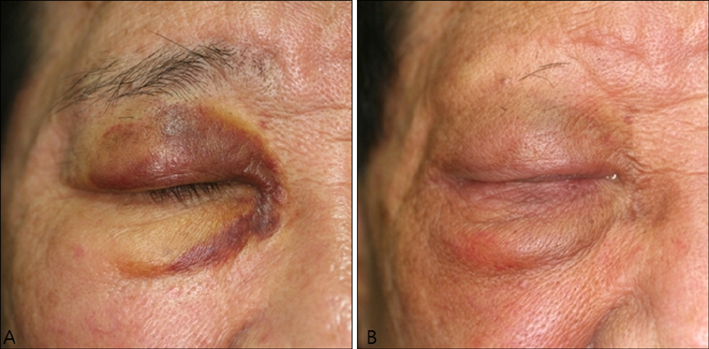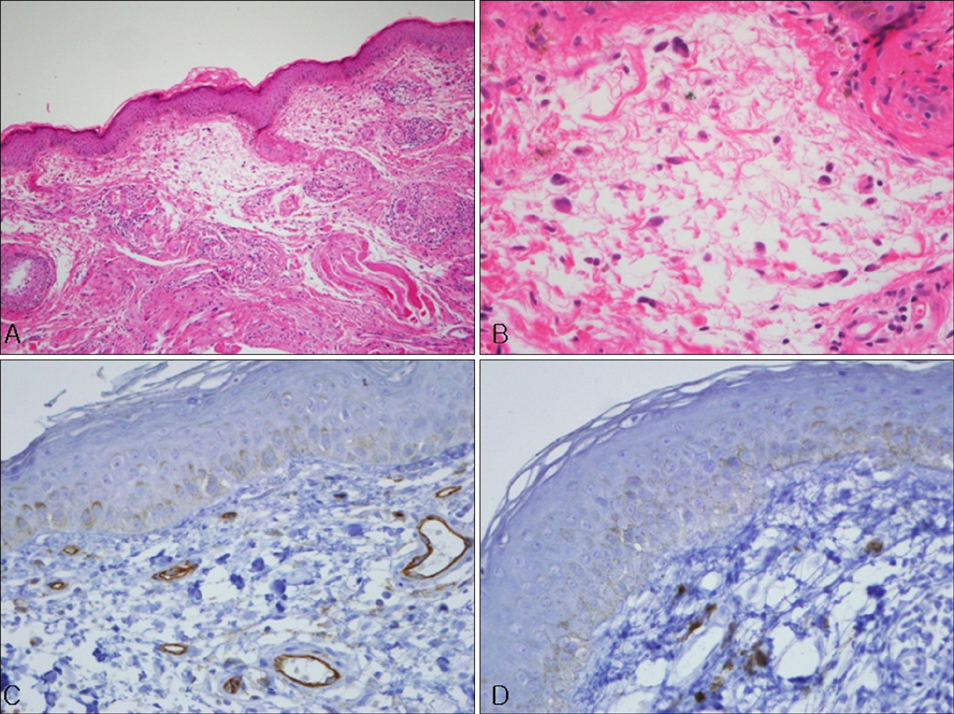Ann Dermatol.
2014 Apr;26(2):231-235. 10.5021/ad.2014.26.2.231.
A Recurrent Angiosarcoma Isolated to the Eyelid without the Recurrence on the Primary Lesion of the Forehead
- Affiliations
-
- 1Department of Dermatology, School of Medicine, The Catholic University of Korea, Seoul, Korea. johnkang@catholic.ac.kr
- KMID: 2171660
- DOI: http://doi.org/10.5021/ad.2014.26.2.231
Abstract
- Angiosarcoma is a highly malignant vascular tumor of endothelial origin. Initially, a cutaneous manifestation presents as a singular or multifocal bruise-like patches on the skin, most frequently on the face, the scalp or the neck regions. On progression, the lesions become violaceous, and ill-defined spongy nodular tumors appear. Our patient was a 71-year-old man with a previous history of angiosarcoma on the right forehead and was treated with an excision and local radiation 3 years ago. Several months after the treatment, a dark brownish to violaceous patch with edema arose from the right upper eyelid and spread out to the lower eyelid. Clinically, an ecchymosis caused by trauma or other hemangioma was suspected more than a recurrent angiosarcoma. Histopathologic examinations including immunohistochemical studies were consistent with cutaneous angiosarcoma. Herein, we report a rare case of a recurrent isolated angiosarcoma without the recurrence of a primary lesion.
Keyword
MeSH Terms
Figure
Cited by 1 articles
-
Primary Angiosarcoma of the Skin Presenting as Mild Erythema
Sun Young Moon, Dong Hyuk Eun, Yong Hyun Jang, Seok-Jong Lee, Do Won Kim, Weon Ju Lee
Ann Dermatol. 2017;29(6):809-810. doi: 10.5021/ad.2017.29.6.809.
Reference
-
1. Mendenhall WM, Mendenhall CM, Werning JW, Reith JD, Mendenhall NP. Cutaneous angiosarcoma. Am J Clin Oncol. 2006; 29:524–528.
Article2. Fuller CK, Charlson JA, Dankle SK, Russell TJ. Dramatic improvement of inoperable angiosarcoma with combination paclitaxel and bevacizumab chemotherapy. J Am Acad Dermatol. 2010; 63:e83–e84.
Article3. Mitra A, Ramnath R, Nicholson S, Yung A. An erythematous nodule on the eyelid. Clin Exp Dermatol. 2008; 33:87–89.
Article4. Lapidus CS, Sutula FC, Stadecker MJ, Vine JE, Grande DJ. Angiosarcoma of the eyelid: yellow plaques causing ptosis. J Am Acad Dermatol. 1996; 34:308–310.
Article5. Gündüz K, Shields JA, Shields CL, Eagle RC Jr, Nathan F. Cutaneous angiosarcoma with eyelid involvement. Am J Ophthalmol. 1998; 125:870–871.
Article6. Hiemstra CA, Mooy C, Paridaens D. Excisional surgery of periocular angiosarcoma. Eye (Lond). 2004; 18:738–739.
Article7. Conway RM, Hammer T, Viestenz A, Holbach LM, Conway RM. Cutaneous angiosarcoma of the eyelids. Br J Ophthalmol. 2003; 87:514–515.
Article8. Wiwatwongwana D, White VA, Dolman PJ. Two cases of periocular cutaneous angiosarcoma. Ophthal Plast Reconstr Surg. 2010; 26:365–366.
Article9. DeMartelaere SL, Roberts D, Burgess MA, Morrison WH, Pisters PW, Sturgis EM, et al. Neoadjuvant chemotherapy-specific and overall treatment outcomes in patients with cutaneous angiosarcoma of the face with periorbital involvement. Head Neck. 2008; 30:639–646.
Article10. Rosen A, Thimon S, Ternant D, Machet MC, Paintaud G, Machet L. Partial response to bevacizumab of an extensive cutaneous angiosarcoma of the face. Br J Dermatol. 2010; 163:225–227.
Article11. Koontz BF, Miles EF, Rubio MA, Madden JF, Fisher SR, Scher RL, et al. Preoperative radiotherapy and bevacizumab for angiosarcoma of the head and neck: two case studies. Head Neck. 2008; 30:262–266.
Article12. Papalas JA, Manavi CK, Woodward JA, Sangueza OP, Cummings TJ. Angiosarcoma of the eyelid: a clinicopathologic comparison between isolated unilateral tumors and tumors demonstrating extrapalpebral involvement. Am J Dermatopathol. 2010; 32:694–699.
Article13. de Keizer RJ, de Wolff-Rouendaal D, Nooy MA. Angiosarcoma of the eyelid and periorbital region. Experience in Leiden with iridium192 brachytherapy and low-dose doxorubicin chemotherapy. Orbit. 2008; 27:5–12.
Article




